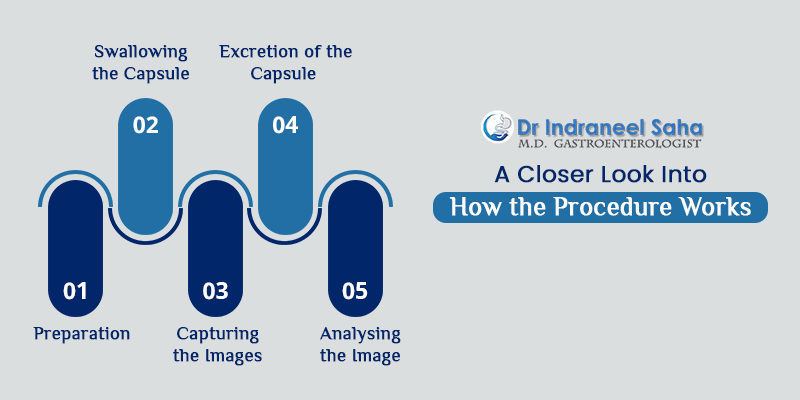- 13th Nov, 2024
- Capsule Endoscopy
How Capsule Endoscopy Works: A Step-By-Step Breakdown
Endoscopy is a popular procedure that allows the doctor to examine the internal organs without any surgical intervention. It is completely a safe technique used to diagnose and treat disorders in the gastrointestinal (GI) tract. Traditional endoscopy involves the insertion of a long flexible tube equipped with a camera, which is passed down into your body through the natural openings such as the mouth or anus. Though the procedure is risk-free; however, it might cause a little discomfort and you may get a feeling of bloating after the examination.
To eliminate such problems, capsule endoscopy is a new and innovative technique that allows gastroenterologists to visualise the GI tract more accurately. This method is extremely useful, especially when other endoscopic procedures cannot reach the areas of the small intestine.
In this blog, we will explore the capsule endoscopy procedure in detail, providing a step-by-step overview of the procedure along with its benefits.
What Is Capsule Endoscopy?
Capsule endoscopy is also a non-invasive method that uses a tiny wireless camera to take pictures of the GI tract. During the procedure, you will be asked to swallow a tiny capsule (about the size of a vitamin pill) that contains a tiny camera. As the pill moves through the small intestine, it captures pictures, which are then transmitted to the recording device worn by the patient around the waist. Within 24 hours, the capsule is excreted through the bowel movement.
A Closer Look Into How The Procedure Works
Here are the steps involved in the capsule endoscopy method.
Step 1: Preparation
You will have a pre-assessment appointment with your doctor where you will be asked to follow certain instructions to prepare yourself for the procedure. For instance, there will be some dietary restrictions, like having light meals the day prior to the examination. Also, before the procedure, you will be prescribed to have a solution for bowel cleansing. If you are taking any medications, make sure to inform your doctor. You might have to stop taking them for a while.
Step 2: Swallowing The Capsule
On the day of the procedure, you will be given a small vitamin-sized pill, which you will be asked to swallow. The pill contains a camera, battery, bulb, battery and radio transmitter. You will also be required to wear a recording device around your waist, which will display the images taken by the capsule.
Step 3: Capturing The Images
As the capsule moves through the stomach, esophagus, intestine, colon and rectum, it captures thousands of images of all the internal organs. These pictures are transmitted to the recording device, allowing for real-time data collection.
Step 4: Excretion Of The Capsule
The capsule remains in the digestive tract and within 12 hours, it leaves the body naturally through bowel movements. However, it will take more time in exceptional cases like people with intestinal obstruction.
Step 5: Analysing The Image
The recorded images will then be analysed by the doctor to detect abnormalities such as tumours, bleeding, or inflammation. Based on the results, your doctor will determine the next treatment plans or other further procedures and tests.

Pros Of Capsule Endoscopy
Capsule endoscopy offers several advantages, including the following:
- Help diagnose a variety of conditions like celiac disease, Crohn’s disease and gastrointestinal cancer. It also helps locate lesions.
- The procedure is safe and painless. You do not need any kind of sedation before the procedure.
- It is minimally invasive with no risk of infections.
- It only takes a few hours.
- It allows a detailed visualisation of the small intestine, which is not possible by other methods.
Images
Conclusion
Capsule endoscopy has emerged as a valuable tool in modern medicine to diagnose conditions in the small intestine, which at times might not be possible by other conventional methods. Still, if you have any concerns, make sure to consult a reputed gastroenterologist who has experience in performing capsule endoscopy procedures to determine if it’s the right choice for you.